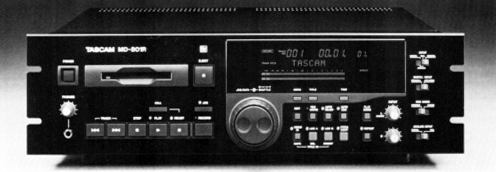
by Jerry Vigil
The MiniDisc format has been around for several years, but it hasn't yet captured the consumer market as planned. Call your local music store and you might find it difficult to even locate prerecorded MDs, let alone blanks. It's the analog cassette that continues to thrive as the consumer's recording medium of choice. It's cheaper, and the quality is better than ever. On the other hand, the professional applications of the MiniDisc format are much more attractive. In effect, this format is the same as the recordable CD, only less expensive. And with the availability of equipment like Tascam's new MD-801, the MiniDisc is likely to begin making some serious inroads into studios in and out of the broadcast field.
The MD-801 is available in two models. The MD-801R is the record/play model, and the MD-801P is the playback only model. This review will examine the MD-801R.
Expecting to see the familiar brown Tascam colors when unpacking the unit, I was pleasantly surprised to see a very attractive black box with dark grey controls. Upon power up, the large amber LED display put the finishing touches to an already good looking front panel.
The back panel provides both balanced and unbalanced analog I/O on XLR and RCA jacks. There is XLR digital I/O for the AES/EBU format and coaxial I/O for S/PDIF. A parallel port and an RS-232C serial port enable remote control from external devices. A keyboard port connects a PS/2 type keyboard for easier entry of track titles and remote control. The power connector completes the rear panel.
A recessed power on/off button is at the top left of the front panel. Just under this are the headphone jack and headphone level control. To the right is the slot for the MiniDisc and an eject key. The load/eject mechanism is incredibly smooth and quiet. You have to listen closely to hear any noise at all when ejecting discs.
The transport controls are at the bottom left. There are the usual PLAY, STOP, RECORD and READY (or pause) keys. Forward and reverse TRACK keys cue to the previous or next track. Press several times to cue past several tracks. The transport control keys are all large and feel durable. Above the PLAY key is a smaller CALL key. Pressing CALL will locate to the beginning of the last recording or to the location stored by pressing the READY key, whichever has occurred last. During playback, press the READY key to enter Pause mode. Pressing the READY key again stores that location in memory for later recall by pressing the CALL key.
Above the RECORD key is the JOG key which engages the large concentric JOG/SHUTTLE controls in the lower center of the front panel. In the JOG mode, the inner control is used to easily cue to any point with single-frame accuracy. There are 86 frames per second so cuing is very precise. (Once a point is located with the JOG wheel, this is a good time to press the READY key to store the location into the CALL key's memory if you want to return to this point.) The outer SHUTTLE wheel is basically your fast-forward and rewind function. The more you turn in either direction, the faster you go.
The large LED display is easy to read and provides ample information. The top portion provides track and time information in various formats selected by pressing the TIME key. The center section is a text area where track titles, menu selections, and other information are displayed. The lower area of the display is dedicated to bargraph level indicators.
At the far right are four slide switches that select the input and record modes. The top INPUT switch selects Unbalanced Analog, Balanced Analog, or Digital. The DIGITAL INPUT switch selects Coaxial or AES/EBU. The ANALOG INPUT switch selects between Uncalibrated and Calibrated. In Calibrated mode, the left and right channel input level controls are bypassed and levels are set to standard +4 or -10. The fourth switch gives the MD-801R a very valuable feature; the RECORD MODE can be set to either Stereo or Mono. In Stereo mode, you get the standard maximum of 74 minutes of recording time per MD. In mono mode, the time doubles, providing 148 minutes of full bandwidth recording. That's almost two and a half hours! (The sampling rate is fixed at 44.1kHz and ATRAC 5:1 data compression is used.) The left and right inputs are summed in analog mono mode. In digital mono mode, only the left channel is recorded.

